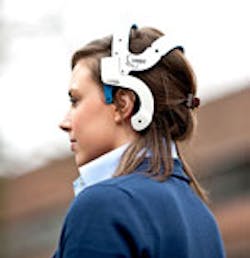EEG headset
No pun intended, the EEG headset is the brainchild of neuro gurus imec and the Holst Centre. Unveiled this past week at the Medical Device and Manufacturing conference and exhibition in Anaheim, California, the prototype headset is capable of recording high-quality EEG signals and transmit them wirelessly in real-time to a receiver at distance up to 10 meters away (see figure). Of note, the headset is compatible with dry electrodes, making it viable and safe for home use.
On first glance, it’s hard not to envision many expansive opportunities for innovation in the medical field. However, the researchers point to target applications in entertainment and infotainment. One possibility is creating adaptive game environments that react to cognitive states. Levels of game difficulty can be automatically set, based on the player’s ability to learn, which would be affected by his or her cognitive load. Summarily, games would self adjust to player ability or preferences. I wonder if that would work with chess or two-handed pinochle.
On a somewhat higher plateau, the helmet’s creators cite the possibility of monitoring automobile drivers for drowsiness and alerting them before they doze off at the wheel. Probably the hardest part of this effort would be convincing drivers to actually wear the helmet. Perhaps if it were made a bit more fashionable, maybe some racing goggles and flame striping. Other medical/safety applications include use as an early warning system for epileptic patients and brain typing of patients with communication disabilities.
A typical monitoring system relies on imec’s eight-channel, analog-readout application-specific integrated circuit (ASIC). A low-power device, the ASIC consumes 200 µW and specifies a common mode rejection ratio of 120 dB and an input-referred noise figure of 55nV/√Hz. Input impedance is fairly high at 1 GΩ, making it compatible for use with dry electrodes. Other specs include a signal to noise ratio of 25 dB and a power consumption of 3.3 mW for continuous recording and transmission of a single channel and 9.2 mW total for eight channels. Depending on the operating mode, the system can perform for one and a half to four days on a 100-mAh Li-ion battery. In addition to the ASIC, a system includes a radio and controller chips housed in a package measuring 25 mm x 35 mm x 5 mm.
EEG recordings performed in hospital or lab settings require trained personnel to apply the electrodes with gel. However, home environments require a system with dry electrodes, one that is easy use and does not require frequent battery recharging. Addressing these requirements, the imec wireless system is integrated within the EEG headset that easily adapts to the head by extending a plastic bridge near the back of the head and by moving the part that contains the electronics upwards or downwards. Above that is a spring suspension and a magnetized pivoting mechanism that can fine-fit the helmet to the head.
Researchers at imec and the Holst Centre have been involved in the neurosciences for quite some time, particularly with brain/machine interfacing. Just last year around this time they unveiled technology capable of transferring thoughts to a computer via a helmet impregnated with highly sensitive sensors (Holey Helmet Reads Minds). For more information, a video is available at www.youtube.com/imecnanotube. For more details on the company’s research and developments in this area, visit www2.imec.be/be_en/research/human-biomedical-electronics/wearable-health-and-monitoring.html.
